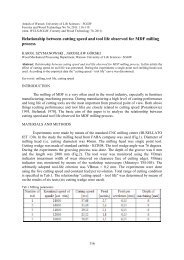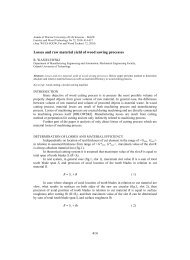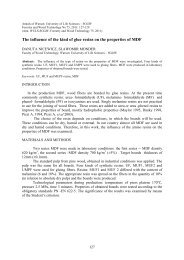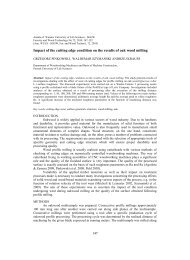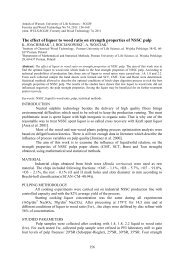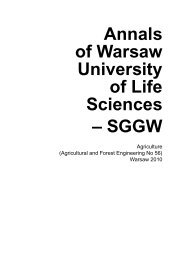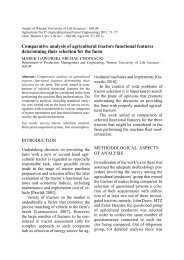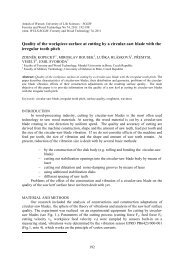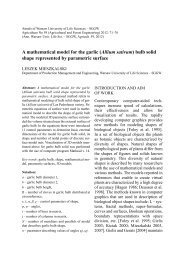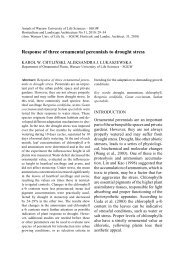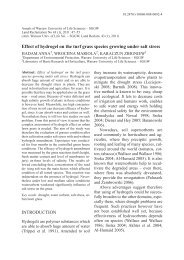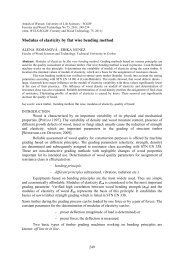Annals of Warsaw University of Life Sciences - SGGW
Annals of Warsaw University of Life Sciences - SGGW
Annals of Warsaw University of Life Sciences - SGGW
Create successful ePaper yourself
Turn your PDF publications into a flip-book with our unique Google optimized e-Paper software.
interesting is the research on the proteins that have a role in underwater adhesion produced by<br />
marine mussels. Research efforts have focused on identifying the genes responsible for the<br />
adhesive proteins and strategies for producing natural adhesives similar to the native mussel<br />
adhesive proteins (SILVERMAN 2007). The adhesives are known for their superior strength<br />
and durability compared with man–made materials. They are ecological and can bind various<br />
materials.<br />
In our experiments, we researched influence <strong>of</strong> chosen modifying agents (hydrolysed<br />
collagen (HC) in combination with activator AG based on glutaraldehyde) on network<br />
formation and the structure <strong>of</strong> cured UF adhesive. We expect modified adhesives to be<br />
stronger and more reactive due to large number <strong>of</strong> –NH 2 groups involved into reactive<br />
mixture by HC. Glutaraldehyde can strengthen the cured adhesive structure, mechanical<br />
strength, elasticity, water resistance and chemical stability.<br />
RESULTS AND DISCUSSION<br />
In experimental work we tested UF and MUF adhesives and hardener R-60. Natural<br />
polymers were added into adhesives in form <strong>of</strong> skin collagen hydrolysate. The hydrolysate<br />
was a liquid: collagen content 26 %, solid content 43 %, and pH = 5.2. Hardener was<br />
modified with activator (AG) based on glutaraldehyde (VIPO a.s.). AG was added into<br />
hardener R-60 in amount 1 % (Hr1), 3 % (Hr3), or 5 % (Hr5).<br />
Plywood was prepared from beech or birch veneers; adhesive spread 160 g.m -2 ,<br />
temperature 105 °C (UF), 130 °C (MUF), specific pressure 1.8 MPa, pressing time 5 minutes.<br />
Shear strength was measured according to EN 314-1,2 standard. Measured values <strong>of</strong> shear<br />
strength were evaluated by one-factor statistical analysis ANOVA on the level α = 0.05.<br />
UF adhesive with activator AG<br />
Firstly, we evaluated influence <strong>of</strong> added hardener on strength and stability <strong>of</strong> glued<br />
joints. Results <strong>of</strong> shear strength for plywood specimens conditioned for adhesive class Nr.1<br />
are given in table 1.<br />
Tab. 1 Shear strength according to EN 314-1,2 standard for adhesive class Nr.1<br />
Adhesive<br />
mixture<br />
Average<br />
Shear<br />
strength<br />
[MPa]<br />
Standard<br />
deviation<br />
[MPa]<br />
Coefficient<br />
<strong>of</strong><br />
variation<br />
[%]<br />
Measured<br />
value min.<br />
[MPa]<br />
Measured<br />
value max.<br />
[MPa]<br />
number<br />
[pcs]<br />
UF+HrR 1.78 0.39 22.08 1.01 2.87 18<br />
UF+Hr1 1.93 0.42 21.71 1.12 2.62 20<br />
UF+Hr3 1.93 0.29 15.05 1.42 2.40 20<br />
UF+Hr5 2.05 0.45 21.78 1.17 2.70 19<br />
Shear strength <strong>of</strong> all tested specimens in adhesive class Nr.1 reached required shear<br />
strength 1.0 MPa. Shear strength <strong>of</strong> joints glued with UF adhesive with modified hardener<br />
was a little higher in comparison with shear strength <strong>of</strong> joint glued with standard adhesive.<br />
AG in adhesive mixture positively influenced shear strength – shear strength <strong>of</strong> joints glued<br />
with mixture with the highest content <strong>of</strong> AG was the highest. Based on one-factor analysis,<br />
we can say that factor “adhesive mixture”, does not influence plywood shear strength statistic<br />
significantly. Adding AG into adhesive mixture shear strength was raised, but not statistic<br />
significantly (fig. 1).<br />
Specimens conditioned for adhesive class Nr.2 collapsed when boiled. UF adhesive<br />
joints with AG stay being classified in adhesive class Nr.1. Expected possibility to classify<br />
modified adhesive joints in adhesive class Nr.2 was not confirmed.<br />
39



